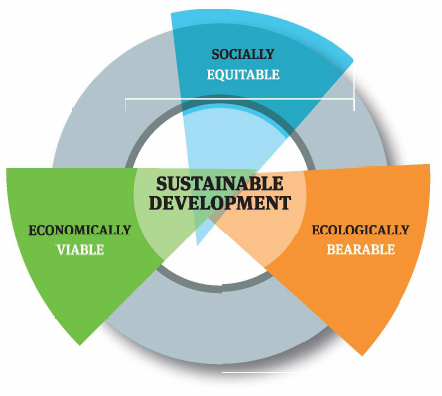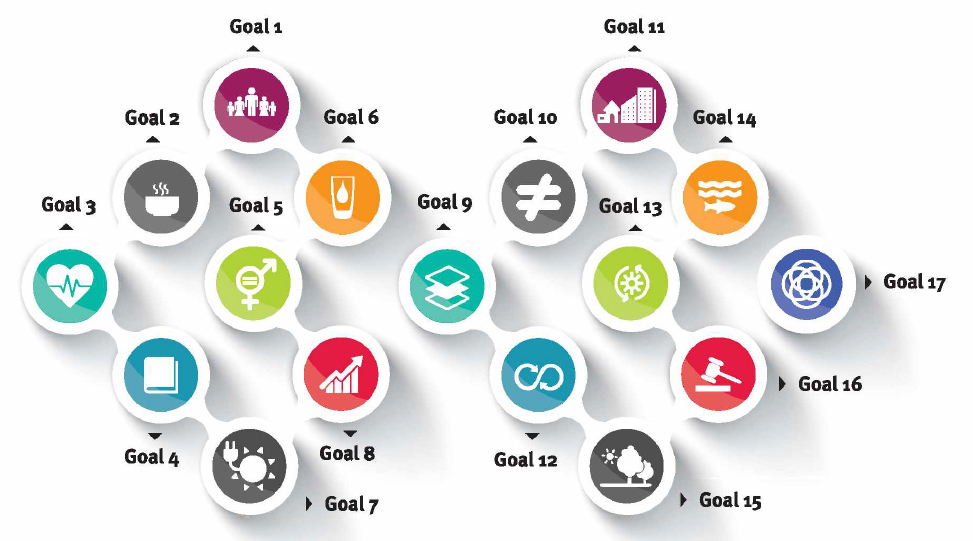Understanding sustainable development
INTRODUCTION
Planet Earth has a limited number of natural resources with fragile life-support systems, and thus, can carry a limited amount of burden. However, in the quest for economic progress and welfare, it is the environment that more often than not, gets compromised. Wide scale environment degradation is the consequent result of society's insatiable appetite for growth and development. There is an urgent need to balance growth and development without putting a burden on Mother Earth. The need of the hour is a development path that is economically viable, socially equitable, and ecologically bearable. This essentially encapsulates the sustainable development concept.
Genesis of sustainable development.
It was way back in 1987 that the United Nation's World Commission on Environment and Development (WCED), also known as the Brundtland Commission formally presented the concept of sustainable development for the very first time in its report 'Our Common Future'. The report is popularly known as The Brundtland Report after the Chair of the Commission and former Prime Minister of Norway, Gro Harlem Brundtland.
Several studies and works such as that of Rachel Carson's Silent Spring (1962), Garret Hardin's Tragedy of the Commons (1968), the Blueprint for Survival by the Ecologist magazine (1972) and the Club of Rome's Limits to Growth report (1972) led to thinking along the lines of sustainable development which got its first major international recognition in 1972 at the UN Conference on Human Environment held at Stockholm which went on to recognise that development and environment are not mutually exclusive but could be carried out in a mutually beneficial way.
The subsequent United Nations Conference on Environment and Development held at Rio de Janeiro in 1992, also known as the 'Earth Summit', formed the basis of the concept of sustainable development wherein strategies and action plans for moving towards a more sustainable pattern of development were forged. Another hallmark in the area of sustainable development was Agenda 21 - which is a blueprint for sustainability in which member countries commit to sustainable development at local and regional levels within their countries that would be monitored by the International Commission on Sustainable Development.
It was the 1992 Earth Summit in Rio de Janeiro that put the concept of sustainable development on national and international policy agendas, with Agenda 21 remaining to be a powerful document providing a long-term vision for balancing economic and social needs with the capacity of the earth's resources and ecosystems.
The World Summit on Sustainable Development (WSSD) in 2002 at Johannesburg resulted in The Johannesburg Plan of Implementation (JPOI). It was the JPOI that reiterated the importance of achieving all internationally agreed development goals embedded in the outcomes of all the major United Nations conferences and international agreements since 1992.
The recent conference on sustainable development was held in 2012; post 20 years of one of the most productive Earth Summit at Rio de Janeiro. The Summit produced the document "The Future We Want" which reaffirmed previous action plans like Agenda 21 and went on to promote the goals of sustainable development and provided recommendations to strengthen its governance.
| YEAR | WORLD SUMMIT | KEY OUTCOMES |
| 1987 | United Nation’s World Commission on Environment and Development(WCED) at Stockholm | Definition and acceptability of the term sustainable development |
| 1992 | United Nations Conference on Environment and Development at Rio de Janeiro also known as the ‘Earth Summit | Translation of deliberation into action with Agenda 21, and landmark conventions on climate change and biodiversity, as well as commitments on poverty eradication and social justice |
| 2002 | World Summit on Sustainable Development (WSSD) at Johannesburg, also known as ‘Rio+io’ | The Johannesburg Plan of Implementation (JPOI) reiterated earlier deliberations and outcomes of all major UN conferences related to sustainable development |
| 2012 | World Summit on Sustainable Development (WSSD) at Rio de Janeiro, also known as ‘Rio+2o’ | An agreement to develop a set of global sustainable development goals (SDGs) and to establish a high-level political forum on sustainable development |
DEFINING SUSTAINABILITY
'Sustainability' normally implies the maintenance of productivity indefinitely (natural or man-made) by the replacement of'resources that are used' with 'resources of equal/greater value' without degrading or compromising the natural ecosystem base. Sustainable development thus ties together the concern for the carrying capacity of natural systems with the social, political, and economic challenges faced by society.
The Brundtland report defined sustainable development as "development which meets the needs of current generations without compromising the ability of future generations to meet their own needs". This broad concept supports robust economic and social progress, in particular for people with a low standard of living, whilst, underlining the importance of protecting the natural resource base and the environment. It makes it amply clear that although it assigns a very strong focus on economic and social well-being, it can't be pursued at the cost of our environment. This is where the concept brings in the element of 'intergenerational solidarity, as it seeks to factor in the ensuing impacts of 'all development' on the 'opportunities for future generations'. The schematic below illustrates the concept of sustainable development perfectly.
In order to achieve sustainable development, it is crucial to harmonize three core elements: economic growth, social inclusion and environmental protection. This implies that for sustainable, inclusive and equitable economic growth of a society, greater opportunities would have to be created for all so as to reduce inequalities, raise basic standards of living, and thereby fostering equitable social development and inclusion - all this with the promotion of sustainable management of natural resources and ecosystems at the bedrock of it all.
It is also important to understand that sustainable development is a process, and not an end in itself. The continuous striving towards achieving economic rationality, while maintaining social justice and ecological equilibrium is quite a humongous task, and will require the cooperation and support from all sectors of the society, where all stakeholders with their major driving goals come together to be integrated for the larger and greater good of a society.
In a nutshell, sustainable development is a process for meeting human development goals while sustaining the ability of natural systems to continue to provide the natural resources and ecosystem services upon which the economy and society depend.

Highlights:
- It was way back in 1987 that the United Nation's World Commission on Environment and Development (WCED), also known as the Brundtland Commission formally presented the concept of sustainable development for the very first time in its report 'Our Common Future'.
- The Brundtland report defined sustainable development as "development which meets the needs of current generations without compromising the ability of future generations to meet their own needs".
- It was the 1992 Earth Summit in Rio de Janeiro that put the concept of sustainable development on national and international policy agendas, with Agenda 21.
- Agenda 21 is a blueprint for sustainability in which member countries commit to sustainable development at local and regional levels within their countries.
- In order to achieve sustainable development, it is crucial to harmonize three core elements: economic growth, social inclusion and environmental protection.
Transforming Our World - The 2030 Universal Agenda For Sustainable Development
The journey so far....
The historic Millennium Development Goals (MDGs) were signed in September 2000 where leaders of 189 countries committed to achieving a set of eight measurable goals that ranged from halving extreme poverty and hunger to promoting gender equality and reducing child mortality, by the target date of 2015. Although, the first MDG of halving the extreme poverty rate by 2015 has been realized, the achievements have been rather uneven. With the MDGs having expired in 2015, the discussion on the post-2015 agenda focused on building a sustainable world where environmental sustainability, social inclusion, and economic development would be equally valued.
The Rio+2o conference (the United Nations Conference on Sustainable Development) in Rio de Janeiro, June 2012, galvanized a process to develop a new set of Sustainable Development Goals (SDGs) which would carry on the momentum generated by the MDGs and fit into a global development framework beyond 20i5.After a sustained global consultation, in July 2014 the UN General Assembly Open Working Group (OWG) proposed a document containing 17 goals to be put forward for the General Assembly’s approval in September 2015. This document set the ground for the new SDGs and the global development agenda spanning from 2015-2030.
The United Nation's Sustainable Development Goals (SDGs) identified for the 2030 Agenda for Sustainable Development, officially came into force on 1st January 2016 after being ratified by all the 193 UN member states. While the SDGs are not legally binding, governments are expected to take ownership and establish national frameworks forthe achievement of the 17 Goals. The 17 SDGs and targets will stimulate action over the next fifteen years in areas of critical importance for humanity and the planet with a 5 dimensional focus being on: People, Planet, Prosperity, Peace, and Partnership.
Over the next fifteen years, countries are to mobilize efforts to end all forms of poverty, fight inequalities and tackle climate change, while ensuring that no one is left behind.
The 17 Sustainable Development Goals:
- Goal 1.End poverty in all its forms everywhere.
- Goal 2. End hunger, achieve food security and improved nutrition and promote sustainable agriculture.
- Goal 3. Ensure healthy lives and promote well-being for all at all ages.
- Goal 4. Ensure inclusive and equitable quality education and promote lifelong learning opportunities for all.
- Goal 5. Achieve gender equality and empower all women and girls.
- Goal 6. Ensure availability and sustainable management of water and sanitation for all.
- Goal 7. Ensure access to affordable, reliable, sustainable and modern energy for all.
- Goal 8. Promote sustained, inclusive and sustainable economic growth, full and productive employment and decent work for all.
- Goal 9. Build resilient infrastructure, promote inclusive and sustainable industrialization and foster innovation.
- Goal 10. Reduce inequality within and among countries.
- Goal 11. Make cities and human settlements inclusive, safe, resilient and sustainable.
- Goal 12. Ensure sustainable consumption and production patterns.
- Goal 13. Take urgent action to combat climate change and its impacts*.
- Goal 14. Conserve and sustainably use the oceans, seas and marine resources for sustainable development.
- Goal 15. Protect, restore and promote sustainable use of terrestrial ecosystems, sustainably manage forests, combat desertification and halt and reverse land degradation and biodiversity loss.
- Goal 16. Promote peaceful and inclusive societies for sustainable development, provide access to justice for all and build effective, accountable and inclusive institutions at all levels.
- Goal 17. Strengthen the means of implementation and revitalize the global partnership for sustainable development.

* Acknowledging that the United Nations Framework Convention on Climate Change is the primary international, intergovernmental forum for negotiating the global response to climate change. Source: UNITED NATIONS, 2016 Acknowledgements: Global Stewards. (2002-2016). How to Live a Sustainable Lifestyle: Three Essential Steps for Creating a Sustainable Life. Government of India, Ministry of Environment & Forests (2006). National Environment Policy 2006. International Institute for Environment and Development (MED). Sustainable Development
